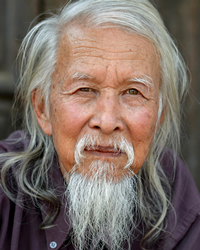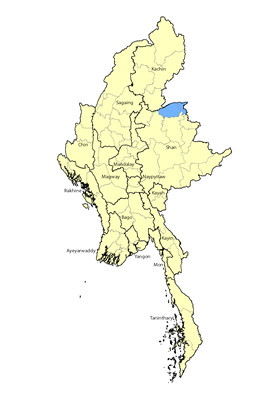The 1931 Burmese census returned 67,691 “Yunnanese” people in Burma, representing the majority of today's Kokang Chinese in Myanmar. Ethnically and culturally they are Han Chinese, but over the past 400 years they have developed a distinct history and group identity that sets them apart from other Chinese groups in Myanmar.
Location: With a population of more than 160,000 people, the Kokang Chinese inhabit a special self-administered zone in Myanmar's northern Shan State, especially in the three townships of Laukkaing, Konkyan, and Muse which form the border between Myanmar and China's Yunnan Province. Until civil war devastated the area in the last two decades, Muse was a major trading hub and accounted for 70 percent of cross-border trade between the two countries. Most commerce ground to a halt in recent years after China constructed a barb-wire electric fence along the boundary.
Language: The Kokang speak Yunnanese Chinese, which is part of the larger Southwestern dialect of Mandarin spoken by approximately 260 million people in China. Although Yunnan speakers may have harsh accents that people in other parts of China struggle to understand, structurally it is similar to standard Mandarin. Chinese linguist Luo Changpei described Southwestern Mandarin as having "simple phonemes, elegant vocabulary, and clear grammar."
Most Kokang are descended from Chinese who migrated to what is now northern Myanmar in the 18th century. Earlier, in 1644, soldiers from the Yang clan fled Nanjing after the collapse of the Ming Dynasty. They made their way to the Yunnan border areas where they formed a feudal state called Kokang. The territory served as a buffer zone between Yunnan and Shan State, and for the past 35 years it has been a special administrative region in Myanmar. The Communist Party of Burma controlled large parts of Kokang from the 1960s to 1989, when the Myanmar National Democratic Alliance Army (MNDAA) took over.3 An uneasy peace persisted until 2009, when fighting between the MNDAA and the Burmese military intensified and continued throughout the 2010s, resulting in thousands of deaths. At the end of 2023 the fierce fighting in Kokang caused the Chinese government to order all its citizens to evacuate from communities near the warzone.5 China's influence in the conflict appears surprisingly limited. They have even failed to intervene when armed rebels have crossed the border into Chinese territory. In January 2024, the MNDAA gained full control of Laukkaing, the capital of Kokang, after thousands of Burmese soldiers surrendered.
During the violence and upheavals that have afflicted the area in recent decades, a power vacuum was filled by gangs of lawless men. Kokang became known as a place of drugs, prostitution, casinos, and human trafficking. The chaos has led to at least 50,000 Kokang people fleeing across the border to China, where many now reside in refugee camps. Kokang cuisine is different from other Chinese varieties. Their special dishes include a rice noodle soup called “Crossing the bridge noodles,” a stir-fry dish known as Da Jiujia which translates as “saving the emperor's life,” and sour, yet delicious, fried goat cheese called rubing.
Although most of the Kokang Chinese are nominally Buddhist due to influence from the Shan and other Tai-speaking groups in the area, ancestor worship also plays a prominent role in their communities. More recent influxes of people from Yunnan are often non-religious, having been influenced by state-promoted atheism during the last 55 years of Communist rule in China.
The 1931 census returned 67,691 Kokang or Yunnanese people in Myanmar yet remarkably, not a single person declared himself a Christian. Today, an estimated two percent of Kokang Chinese are followers of Christ. The Chinese Bible is nearly impossible to obtain in the region, but many Kokang people are unable to read the Simplified Chinese script, which was created by Mao Zedong's government in the 1950s. The Jesus film is available in the Yunnan dialect of Mandarin.
Scripture Prayers for the Han Chinese, Kokang in Myanmar (Burma).
| Profile Source: Asia Harvest Copyrighted © Used with permission |











